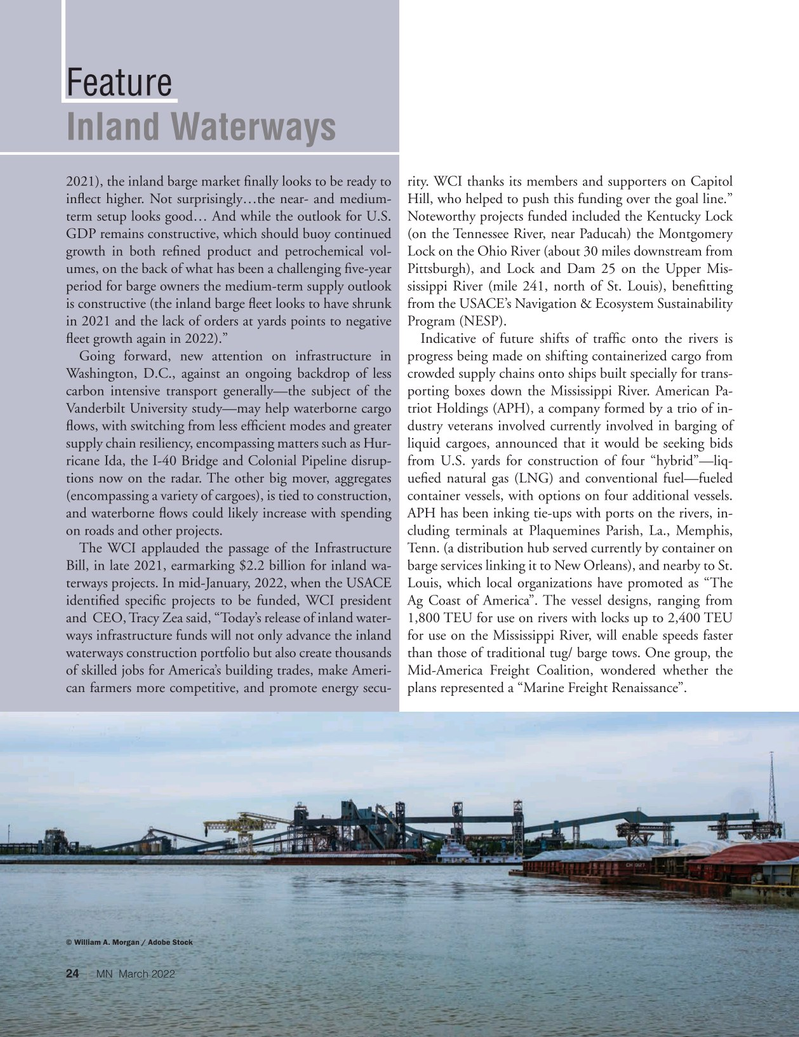
Page 24: of Marine News Magazine (March 2022)
Pushboats, Tugs & Barges
Read this page in Pdf, Flash or Html5 edition of March 2022 Marine News Magazine
Feature
Inland Waterways 2021), the inland barge market ? nally looks to be ready to rity. WCI thanks its members and supporters on Capitol in? ect higher. Not surprisingly…the near- and medium- Hill, who helped to push this funding over the goal line.” term setup looks good… And while the outlook for U.S. Noteworthy projects funded included the Kentucky Lock
GDP remains constructive, which should buoy continued (on the Tennessee River, near Paducah) the Montgomery growth in both re? ned product and petrochemical vol- Lock on the Ohio River (about 30 miles downstream from umes, on the back of what has been a challenging ? ve-year Pittsburgh), and Lock and Dam 25 on the Upper Mis- period for barge owners the medium-term supply outlook sissippi River (mile 241, north of St. Louis), bene? tting is constructive (the inland barge ? eet looks to have shrunk from the USACE’s Navigation & Ecosystem Sustainability in 2021 and the lack of orders at yards points to negative Program (NESP). ? eet growth again in 2022).” Indicative of future shifts of traf? c onto the rivers is
Going forward, new attention on infrastructure in progress being made on shifting containerized cargo from
Washington, D.C., against an ongoing backdrop of less crowded supply chains onto ships built specially for trans- carbon intensive transport generally—the subject of the porting boxes down the Mississippi River. American Pa-
Vanderbilt University study—may help waterborne cargo triot Holdings (APH), a company formed by a trio of in- ? ows, with switching from less ef? cient modes and greater dustry veterans involved currently involved in barging of supply chain resiliency, encompassing matters such as Hur- liquid cargoes, announced that it would be seeking bids ricane Ida, the I-40 Bridge and Colonial Pipeline disrup- from U.S. yards for construction of four “hybrid”—liq- tions now on the radar. The other big mover, aggregates ue? ed natural gas (LNG) and conventional fuel—fueled (encompassing a variety of cargoes), is tied to construction, container vessels, with options on four additional vessels. and waterborne ? ows could likely increase with spending APH has been inking tie-ups with ports on the rivers, in- on roads and other projects. cluding terminals at Plaquemines Parish, La., Memphis,
The WCI applauded the passage of the Infrastructure Tenn. (a distribution hub served currently by container on
Bill, in late 2021, earmarking $2.2 billion for inland wa- barge services linking it to New Orleans), and nearby to St. terways projects. In mid-January, 2022, when the USACE Louis, which local organizations have promoted as “The identi? ed speci? c projects to be funded, WCI president Ag Coast of America”. The vessel designs, ranging from and CEO, Tracy Zea said, “Today’s release of inland water- 1,800 TEU for use on rivers with locks up to 2,400 TEU ways infrastructure funds will not only advance the inland for use on the Mississippi River, will enable speeds faster waterways construction portfolio but also create thousands than those of traditional tug/ barge tows. One group, the of skilled jobs for America’s building trades, make Ameri- Mid-America Freight Coalition, wondered whether the can farmers more competitive, and promote energy secu- plans represented a “Marine Freight Renaissance”. © William A. Morgan / Adobe Stock 24 | MN March 2022

 23
23

 25
25
